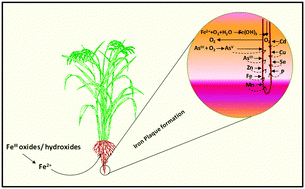Roles for root iron plaque in sequestration and uptake of heavy metals and metalloids in aquatic and wetland plants
Abstract
Toxic metal(loid) contamination of soil and sediment poses long term risk to soil and human health through plant–human or plant–animal–human food chain pathways. Iron plaque (IP) formation is frequent in aquatic and wetland plant species and is responsible for the sequestration of various metal(loids). The presence of IP may act as a buffer or barrier and may thus enhance or reduce the uptake of potentially phytotoxic metals and metalloids by plants. If IP acts as a barrier, then low IP producing macrophytes/aquatic plants may be better accumulators of toxic metals and may find use in constructed wetlands for remediation of pollutants, while high IP forming edible plant species could be safer for human consumption. Conversely, if IP acts as a buffer for mineral nutrients and toxic elements then those cultivars may be rich in nutrients, but may also cause toxicity. However, an ecotoxicological risk is also inevitable if IP rich macrophyte roots containing heavy metals are consumed by herbivores. In this review, we summarize the current understanding about the role of IP in metal and metalloid sequestration, uptake, and transport. Furthermore, we will address the role of root IP in Oryza sativa for arsenic (As) sequestration leading to lower grain As translocation, reducing the risk of human exposure.

- This article is part of the themed collection: Metals in marine biochemistry

 Please wait while we load your content...
Please wait while we load your content...